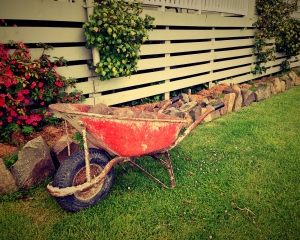To the left of our Southern California driveway is a little plot of land, 400-500 square feet. Some homeowners just pave over a space like this, to add another parking spot, or a place for a basketball hoop and room to play. When we moved into our house 18 years ago, it contained three liquid amber trees (we called them the spiky-ball trees in honor of the seed pods they threw off in the fall), and a tangle of daisies, jasmine, and assorted weeds. We had the liquid amber trees removed 8 years ago (too late to save the driveway from their roots), and left the tangle until recently. It was a mess, but at least it was green, and the daisies and jasmine produced a reliable if disorderly riot of pretty flowers every year.
Over the course of the last year or so we have turned our attention to this little plot, seeking to bring a bit more order to it, and perhaps save on the water bill. Because my wife and I appreciate beautiful things, but neither of us knows much about gardening, we sought advice from a local nursery. Dorothy, a pleasant woman with a quiet love and knowledge of gardens and landscapes, came out, looked at the plot, and designed a garden, all for a very modest fee. By last May (nine months after the consultation – we move slowly but surely), we were ready to implement the plan. We evicted the last of the daisies, jasmine, mini-palms, and young liquid amber trees. A half-scoop of compost replaced a similar amount of clay soil – or more accurately, large clay rocks; the clay rocks sat in a pile on our driveway, slowly disappearing into the trash barrel over the course of two months.
Then came the planting. The garden itself is organized around a pineapple guava tree toward the back, surrounded by three tufts of fountain grass. Toward the front is an ensemble of Nandina bushes (delicate red leaves, white flowers, and red berries), clumps of bronze-leaved Jack Spratt phormium, and three otherworldly coral aloes. For ground cover we planted Angelina sedum (stonecrop), whose greens and oranges serve as a bright stage for the other plants. At the very back, along the sidewalk to the side yard, we planted tightly spaced blue fescue.
Once the garden was in, I regularly soaked the roots of the new plants as instructed, cleared away the weeds regularly, and waited for God to give the growth. There were several mini-crises: the guava’s leaves turned brown and began to fall off, a fifth of the fescue clumps turned from blue to brown, and of all things the seemingly indestructible Jack Spratts seemed browner than bronze. All of these symptoms called for more water and our drought-tolerant plants are now thriving (I’m still concerned about the Jack Spratts).
Although the garden does not take a lot of time, I am devoted to it, and my wife and youngest son accuse me of going all crunchy-con on them. I’m not in danger of going green, but it is very satisfying to plant a beautiful ensemble of plants and care for them. My little plot is more beautiful than it used to be, and I enjoy its beauty.
There is much I could say about my garden and its wider effects on society and culture, but I think I’ll just stick to the beauty and satisfaction. It is beautiful, simply. In cultivating it I am not cultivating a program of cultural reform, nor participating in some back-to-the land localism. My garden is not changing my politics, even at the local level (although I have met some neighbors I didn’t know before). I suppose I am more of a homeowner now that I have improved my land, but I wasn’t trying to become more of a homeowner. I just wanted to plant a garden.
Flower gardens and vegetable gardens may change us in important ways, but I don’t plant them to change myself or my community. It is too easy to lose sight of this simple fact; in tracing out the healthy effects of beautiful things we may lose sight of their basic purpose.
I think every fundamentally good thing in life is like my garden – good in itself, good instrumentally in its effects, but good instrumentally only to the extent that it is good in itself. A community garden whose purpose is not the beauty of the garden, the goodness of the food, and the goodness of the work, but whose purpose is instead some other community good which gardens might produce, will not work that well. It’s got to be about the garden. Marriage, for example, is a basic institution, and the source of many important communal goods – neighborhoods are more secure, more neighborly, more nurturing when marriages are strong. But marriage is only instrumentally good for communities because it is fundamentally, humanly good in itself. People will not get married and stay married for the good of their community. Being truthful in your business dealings is humanly good in itself, and may in fact be good for your business, but if you are honest only because it is good for profits you won’t be honest for long (to the detriment of your soul), and you will lose any of the business benefits of truthfulness.
I think I’ll start a vegetable garden in the spring, but I won’t start a local coop to sell the produce. I don’t want the garden to be something bigger than it is, because I don’t want it to be less than it is.






1 comment
Jason Fisher
Excellent, Andrew.
When I first lived in Greece, studying the classics, on a trip the very interior of Crete we visited an ancient site way up on the tip of a crag in the midst of a verdant valley. The question my professor raised was “why is this here? why did people live here and thresh their grain here, when the fields were a mile or more away below us and there were no pirates this far inland?” His recommended theory: The Beautiful View Theory = we could see mile after mile of beautiful landscape from there, every direction, productive, but from that vantage, just simply beautiful.
When we plant a garden in our tiny, suburban backyard in middle America, and then we fail to maximize the veggies from it, I still think, “Yes, but it’s a beautiful view.”
Comments are closed.